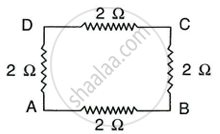Advertisements
Advertisements
प्रश्न
उत्तर
The charge on one electron is 1. 6 x 10-19 coulombs.
Therefore, lC charge carries `(1/(1.6 xx 10^19))` = 6.25 x 1018 electrons.
APPEARS IN
संबंधित प्रश्न
In the circuit diagram given below five resistances of 10 Ω, 40 Ω, 30 Ω, 20 Ω, and 60 Ω are connected as shown to a 12 V battery.

Calculate:
(a) total resistance in the circuit.
(b) total current flowing in the circuit.
If the current passing through a conductor is doubled, what will be the change in heat produced
In the network shown in the following adjacent Figure, calculate the equivalent resistance between the points.
- A and B
- A and C

State the relation between work, charge and potential difference for an electric circuit.
What is the criteria for selecting a fuse wire?
Explain, why the potential difference across the terminals of a cell is more when the cell is not in use than it is when the cell is being used.
A current of 2A passing through the conductor produces 80 J of heat in 10 seconds. The resistance of the conductor is ______.
